The earliest Chinese medical text, the “Huangdi Neijing” or “The Yellow Emperor’s Classic of Internal Medicine,” documented only 13 herbal formulas, and one of them is a liquid derived from Five Grains (cereals). In ancient times, rice porridge was used medicinally for treating illnesses. Different types of rice were believed to possess distinct therapeutic effects, contributing to overall body nourishment and good health. In this article, we will outline the key benefits of various types of rice.
Myth: Diabetic Patients Should Avoid Eating Rice
White rice is believed to benefit the spleen and stomach, providing the body with energy and enhancing vitality. In traditional Chinese medicine (TCM), the spleen not only plays a role in the immune system but also governs the body’s digestive system. The vital energy (qi) that circulates within the body and the blood that carries various nutrients both rely on the nutritional substances acquired through the spleen and stomach. It is essential to note that the TCM concept of zangfu (organs) does not necessarily correspond to the anatomical organs in modern Western medicine.White Rice as a Medicinal Ingredient
White rice is considered a medicinal ingredient in TCM. It is included in various herbal formulas, including the White Tiger Decoction, Ophiopogon Japonicus Decoction, and the Lung-nourishing Ejiao Formula, where it plays a role in safeguarding the gastrointestinal system and lungs.According to TCM, meridians are the channels through which energy flows in the human body. The body consists of 12 major meridians, each corresponding to a specific organ. Each meridian has a particular time of day when it is most active.
Black Rice: Nourishing the Kidneys and Darkening Hair
Black rice, also known as black glutinous or forbidden rice, is a whole-grain rice. It has a coarse, non-sticky texture when cooked and is often referred to as the “medicinal king of rice” due to its numerous health benefits. Black rice is believed to nourish the kidneys, promote dark and healthy hair, replenish blood, and warm the spleen and stomach. It is especially suitable for individuals with weaker digestive systems, knee discomfort, older people, children, and those with diabetes.
The most valuable part of black rice is its outer black layer, which contains a high amount of anthocyanins comparable to those found in blueberries. Anthocyanins are known for their antioxidant properties and ability to protect the eyes, combat aging, and prevent cardiovascular issues.
Purple Rice: Nourishing Blood and Enhancing Beauty

Purple rice, or purple glutinous rice, is characterized by its high stickiness, which can be hard to digest when eaten on its own and may lead to bloating when consumed excessively.
Brown Rice Versus White Rice: Which Is More Nutritious?
What are the differences between brown, white, and germinated brown rice? Brown rice is obtained by removing the outer husk of rice grains, leaving the bran and germ. Germinated brown rice is brown rice with the bran layer removed, leaving only the germ. White rice, on the other hand, is rice from which the germ on top has been removed.3 Ways to Prepare Brown Rice for Easier Digestion
Brown rice has a firmer texture, potentially causing stomach discomfort for individuals with digestive issues like bloating or gastric ulcers.1. White Rice + Brown Rice
Combine white and brown rice in a 4:1 ratio and cook them together. Begin by soaking the brown rice for 40 minutes, then cook it alongside the white rice. This cooking method produces rice with a chewy yet tender texture, offering a delightful aroma and excellent mouthfeel.2. White Rice + Brown Rice + Sweet Potato
Combine white rice, brown rice, and a small amount of sweet potato and cook them together. You can cut the sweet potato into chunks, cubes, or shreds. Adding sweet potato to the rice provides a softer texture and a hint of sweetness. This addition also provides a sense of fullness and promotes digestion. Cooking the rice in a pressure cooker or clay pot can enhance flavor.3. Brown Rice Porridge With Milkfish
If you are worried that brown rice might be difficult to chew, especially for older individuals and children, you can prepare it as brown rice porridge. Here are the steps for preparing Brown Rice Porridge With Milkfish:- Precook the brown rice and set it aside.
- Wash and cut the milkfish belly into pieces.
- Bring water to a boil, add the fish belly, and let it simmer. Then, add the precooked brown rice.
- Once fully cooked, add some chopped celery and cilantro and season with salt and pepper.

How to Choose Fresh Rice
When purchasing rice, it is essential to select grains that are whole and have minimal breakage or white powder. If the rice is broken and has a powdery texture, it suggests poor rice quality, possibly due to oxidation or spoilage. Avoid buying this type of rice.White rice may naturally contain insect eggs, which may hatch into rice weevils if the rice is stored for an extended period. To prevent this, place a few dried garlic cloves in a cloth bag and put them in the rice container. This can serve as a natural insect repellent. However, it is important to note that damp garlic cloves may result in rice mold instead.







